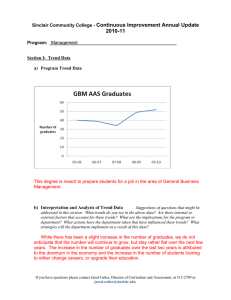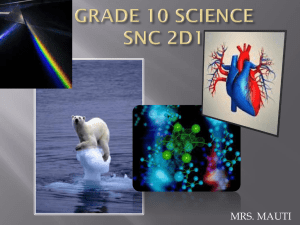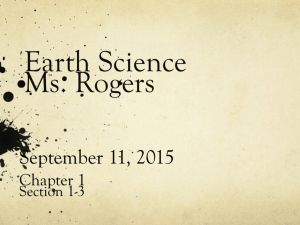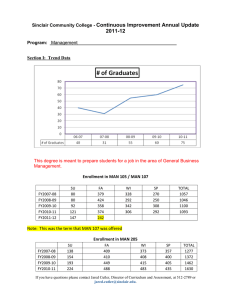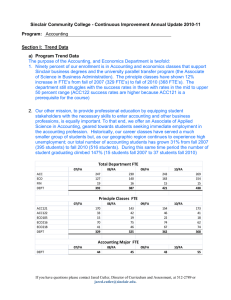Continuous Improvement Annual Update 2011-12
advertisement
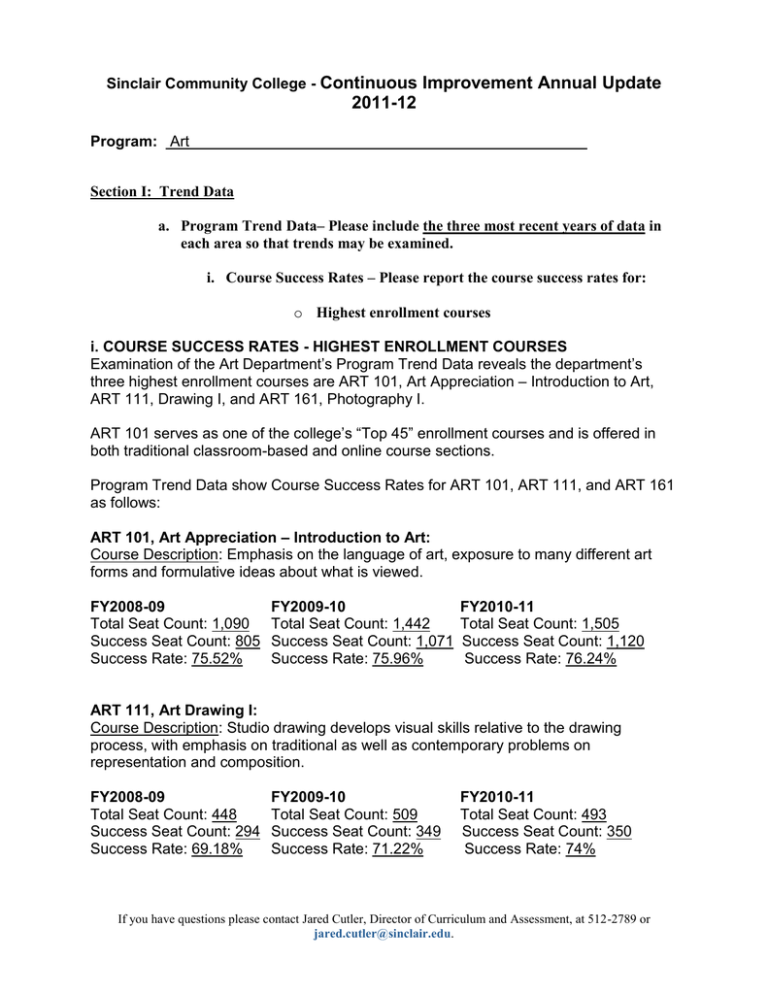
Sinclair Community College - Continuous Improvement Annual Update 2011-12 Program: Art Section I: Trend Data a. Program Trend Data– Please include the three most recent years of data in each area so that trends may be examined. i. Course Success Rates – Please report the course success rates for: o Highest enrollment courses i. COURSE SUCCESS RATES - HIGHEST ENROLLMENT COURSES Examination of the Art Department’s Program Trend Data reveals the department’s three highest enrollment courses are ART 101, Art Appreciation – Introduction to Art, ART 111, Drawing I, and ART 161, Photography I. ART 101 serves as one of the college’s “Top 45” enrollment courses and is offered in both traditional classroom-based and online course sections. Program Trend Data show Course Success Rates for ART 101, ART 111, and ART 161 as follows: ART 101, Art Appreciation – Introduction to Art: Course Description: Emphasis on the language of art, exposure to many different art forms and formulative ideas about what is viewed. FY2008-09 Total Seat Count: 1,090 Success Seat Count: 805 Success Rate: 75.52% FY2009-10 Total Seat Count: 1,442 Success Seat Count: 1,071 Success Rate: 75.96% FY2010-11 Total Seat Count: 1,505 Success Seat Count: 1,120 Success Rate: 76.24% ART 111, Art Drawing I: Course Description: Studio drawing develops visual skills relative to the drawing process, with emphasis on traditional as well as contemporary problems on representation and composition. FY2008-09 Total Seat Count: 448 Success Seat Count: 294 Success Rate: 69.18% FY2009-10 Total Seat Count: 509 Success Seat Count: 349 Success Rate: 71.22% FY2010-11 Total Seat Count: 493 Success Seat Count: 350 Success Rate: 74% If you have questions please contact Jared Cutler, Director of Curriculum and Assessment, at 512-2789 or jared.cutler@sinclair.edu. ART 161, Photography I: Course Description: An introduction to the art and technique of black and white photography. Photographic shooting, processing, and printing are stressed. Students to supply their own adjustable camera (35mm or 120), film and print paper. Two lecture, four lab hours per week. FY2008-09 Total Seat Count: 216 Success Seat Count: 143 Success Rate: 68.75% FY2009-10 Total Seat Count: 244 Success Seat Count: 170 Success Rate: 71.13% FY2010-11 Total Seat Count: 231 Success Seat Count: 148 Success Rate: 66.67% o Any courses that deviate - high and low - from the typical success rate for your department DEVIATIONS – HIGH SUCCESS RATE: Examination of the Art Department’s Program Trend Data reveals the following courses consistently maintain high success rates over the course of FY2008-09 – FY2010-11: ART 121, Painting I: Course Description: Studio painting, basic color principles with emphasis on color, form, and space in compositional design. Two lecture, four lab hours per week. Prerequisite: ART 111, Drawing I FY2008-09 Total Seat Count: 75 Success Rate: 90.38% FY2009-10 Total Seat Count: 74 Success Rate: 84.29% FY2010-11 Total Seat Count: 78 Success Rate: 91.67% ART 133, Sculpture III: Course Description: Personal development and expression of style; participation in critiques and discussion; projects involve integration of materials and an environmental piece. Two lecture, four lab hours per week. Prerequisites: ART 131, Sculpture I; ART 132, Sculpture II. FY2008-09 Total Seat Count: 33 Success Rate: 84% FY2009-10 Total Seat Count: 24 Success Rate: 100% FY2010-11 Total Seat Count: 26 Success Rate: 90% ART 162, Photography II: Course Description: Intermediate course in black and white photography. Further introduction and application of the tools and techniques of the photographic art. Student to supply own adjustable camera (35mm or 120), film and print paper, retouching supplies, and photo mounting supplies. Two lecture, four lab hours per week. Prerequisite: ART 161, Photography I. FY2008-09 Total Seat Count: 40 Success Rate: 89.47% FY2009-10 Total Seat Count: 34 Success Rate: 97.06% FY2010-11 Total Seat Count: 36 Success Rate: 94.29% If you have questions please contact Jared Cutler, Director of Curriculum and Assessment, at 512-2789 or jared.cutler@sinclair.edu. ART 163, Photography III: Course Description: Advanced photographic techniques. Specialized darkroom techniques, special purpose films and processes are explored. Student to supply own adjustable camera (35mm or 120 or 4x5), film and print paper, retouching supplies, and dry mounting agents. Two lecture, four lab hours per week. Prerequisites: ART 161, Photography I; ART 162, Photography II. FY2008-09 Total Seat Count: 23 Success Rate: 95% FY2009-10 Total Seat Count: 35 Success Rate: 97.14% FY2010-11 Total Seat Count: 29 Success Rate: 96.55% DEVIATION – LOW SUCCESS RATE: Examination of the Art Department’s Program Trend Data reveals the following course had a deteriorating success rate over the course of FY2008-09 – FY2010-11: ART 151, Art as Therapy I: Course Description: Art in the therapeutic process utilizing exploration of art media, basic art therapy techniques, and art-related diagnostic tools. (Also offered as MHT 151; students may enroll in either course but not both. Prerequisites: DEV 065; DEV 110. FY2008-09 Total Seat Count: 10 Success Rate: 77.78% FY2009-10 Total Seat Count: 11 Success Rate: 60% FY2010-11 Total Seat Count: 10 Success Rate: 50% ii. Degree and certificate completion (where applicable) ii. DEGREE AND CERTIFICATE COMPLETION AC2008-09 AC2009-10 AC2010-11 ART.AA-Art 12 12 07 ART.WSU.AA-Art 02 02 03 DRWG.STC 04 02 03 PHOT.STC 23 24 26 iii. Any additional data that illustrates what is going on in the program (examples might include course sequence completion, retention, demographic data, data on placement of graduates, graduate survey data, etc.) While important and of interest to the Art Department, the Current Student Survey Responses report housed in the DAWN Portal only provides data for the years 19982006. It would be helpful to review more current data. 2006 data show a relatively low response rate of 8 Art students compared to1395 overall respondents. If you have questions please contact Jared Cutler, Director of Curriculum and Assessment, at 512-2789 or jared.cutler@sinclair.edu. 2006 data indicate Art students were generally pleased with instructors’ willingness to help (Dept: 4.63; Overall: 4.51), believed they were treated with respect (Dept: 4.75; Overall: 4:49), and coursework is challenging (Dept: 4.13; Overall: 4.14). In contrast, 2006 data indicate students did not feel materials were available when needed (Dept: 3.63; Overall: 4.12) and classrooms were not necessarily comfortable to work in (Dept: 3.88; Overall 4.12). In terms of material availability, the Art Department makes every effort to ensure materials and equipment are readily available for student use. This fact is clearly evidenced by department spending for classroom/lab supplies and equipment maintenance. However, students are also required to provide materials for studio courses as outlined in course syllabi. Because art materials tend to be somewhat costly - especially for students enrolled in multiple studio-based courses per term - some students may avoid purchasing required course materials. In regard to classroom facilities, the Art Department boasts excellent, well-maintained studio spaces. Student dissatisfaction may result from the often crowded conditions existing in some of the department’s studio-based courses. This is especially true in terms of the department’s dramatically undersized Printmaking studio that only safely accommodates 8 students. However, in a response to move closer to the 18-student Average Class Size, this number has been pushed to 10 and, during one unfortunate quarter, 12 students, with less than satisfactory results. b. Interpretation and Analysis of Trend Data Included in the Section Above Suggestions of questions that might be addressed in this section: What trends do you see in the above data? Are there internal or external factors that account for these trends? What are the implications for the program or department? What actions have the department taken that have influenced these trends? What strategies will the department implement as a result of this data? i. COURSE SUCCESS RATES The Art Department’s Program Trend Data reveals enrollment in ART 101, Art Appreciation – Introduction to Art experienced a relatively dramatic increase of 415 students between FY2008-09 (1090) and FY2010-11 (1505). The ongoing expansion of online ART 101 course sections serves as a reasonable explanation for this sizable increase. Fortunately, success rates have kept pace with the increase in enrollment and have risen almost 1% during this period. As one of the college’s “Top 45” courses, a high overall success rate is imperative. As this data confirm, the continued expansion of online course offerings has enhanced the department’s overall enrollment in ART 101 courses. The high success rates in ART 111, Art Drawing I and ART 161, Photography I suggest the use of portfolio assessment and one-on-one instruction in the studio environment are proving successful in terms of student learning and persistence. The slight drop in student success rates between FY2009-10 and FY2010-11 may be the result of If you have questions please contact Jared Cutler, Director of Curriculum and Assessment, at 512-2789 or jared.cutler@sinclair.edu. attempts to adjust curriculum and instructional methods to improve students’ comprehension of core content knowledge in preparation for ART 162, Photography II. Consistently high success rates in ART 121, Painting I indicate the preparatory prerequisite course, ART 111, Art Drawing I, is successfully preparing students to progress to more advanced levels of artistic study. Consistently low enrollment and declining success rates for ART 151, Art as Therapy I led to the decision to deactivate this course. Because ART 151 was also concurrently offered as MHT 151 and taught by the same instructor, the decision to deactivate this course was made in collaboration with the Chairperson of the Mental Health Technologies Department. ii. DEGREE AND CERTIFICATE COMPLETION DEGREE COMPLETION: Examination of the Art Department’s Program Trend Data for program graduates by fiscal year show the ART.AA-Art degree program remained consistent at 12 graduates during AC2008-09 and AC2009-10. However, data for AC2010-2011 show a slight decrease in the number of graduates for the ART.AA-Art degree program which dropped from 12 graduates during AC2009-10 to 7 graduates during AC 2010-11. The number of graduates completing the ART.WSU.AA-Art degree program remained consistent at 2 graduates during AC2008-09 and AC2009-10. However, data for AC2010-2011 show an increase from 2 graduates during AC2009-10 to 3 graduates during AC2010-11. When combined (ART.AA-Art, ART.WSU.AA-Art), 10 students graduated with Associate’s degrees during AC2010-11 – a 4 student drop from the previous academic year. While the slight decrease in graduation rates experienced during AC2010 serves as cause for concern, Art Department faculty members continue to strongly encourage Art majors to persist to graduation. As previously noted in the 2010-11 Continuous Improvement Annual Update, the economic climate may prove to be an even greater challenge as many students are re-training for new careers as a means to attain gainful employment upon program completion. Since the ART.AA and ART.WSU.AA degree programs are not career-track degree programs, but, rather lead, by transfer, to baccalaureate degree programs, some students may forgo completing the ART.AA and ART.WSU.AA degree programs or decide not to enroll as art majors in a transfer program in favor of a career-track degree program. CERTIFICATE COMPLETION: Data for the Basic Drawing Short Term Certificate (DRWG.STC) show 4 students completed the certificate program during AC2008-09, with a drop to 2 students during AC 2009-10. During AC2010-11, 3 students completed the certificate program. Historically, the Basic Drawing Short Term Certificate program has consistently produced a low number of program completers. This certificate program is intended to serve as an enrichment program providing students with a broad range of styles and historic sources for their work, whether the individual is a graphic designer or freelance illustrator. If you have questions please contact Jared Cutler, Director of Curriculum and Assessment, at 512-2789 or jared.cutler@sinclair.edu. Data for the Photographic Technology Short Term Certificate (PHOT.STC) show 23 students completed the certificate program during AC2008-09. During AC2009-10, the number of program completers rose to 24 students with an additional increase to 26 program completers during AC2010-11. Because the Photographic Technology Short Term Certificate is designed for the serious photographer or student who desires to find a job in the photo studio/photo processing industry, the increase in program completers may reflect the desire of students to open their own photography studios or attain employment in the photography industry. Section II: Progress Since the Most Recent Review a) What was the fiscal year of the most recent Program Review for this program? (The most recent Program Review self-study can be found at http://www.sinclair.edu/about/administrative/vpi/pdreview/ ). FY2006-07 b) Briefly summarize the goals that were listed in Section IV part E of the most recent Program Review Self-Study (this section of the Self-Study asks “What are the department’s/program’s goals and rationale for expanding and improving student learning, including new courses, programs, delivery formats and locations”)? Photography – Associate of Applied Science (A.A.S.): In March 2006, The Art Department submitted a preliminary approval form for the Ohio Board of Regents (OBR) to Sue Merrell, Director of Curriculum at Sinclair Community College. The Art Department requested preliminary approval for a new Associate of Applied Science (A.A.S.) degree in Photography. This A.A.S. degree program was developed primarily from courses already in place and required the creation of only three new courses. With the exception of an expensive proprietary school, OIP&T, no public institution in a 30-mile radius offers this degree. A survey of current Photography certificate students and students seeking the A.A. degree with a concentration in Photography were surveyed and showed an overwhelming interest in the A.A.S. degree in Photography. In conjunction with Sinclair’s low tuition, NCA accreditation, and the department’s National Association of Schools of Art and Design (NASAD) accreditation, the Photography A.A.S. degree would attract new students to Sinclair as well as addressing the community’s need for credentialed commercial photographers. Painting/Anatomy & Life Drawing Expanded Course Sections: In response to student requests, the Art Department expanded its painting courses to include classes meeting once per week on Fridays, on weekends, and during summer quarter. Students also requested an increase in Anatomy & Life Drawing course sections beyond the typical daytime course offerings. In response, the Art Department offered an additional evening course section. If you have questions please contact Jared Cutler, Director of Curriculum and Assessment, at 512-2789 or jared.cutler@sinclair.edu. Art History Web Course Development: In an attempt to provide students with an alternative mode of course instruction, the Art Department would like to development the Art History survey courses - ART 231, Art of the Ancient World, ART 232, Art of the Medieval & Renaissance Worlds, ART 233, Art of the Modern World - as web courses. Expansion of Online Course Offerings: The continued expansion of Art Department web course offerings will continue to enhance enrollment and efficiency. The Art Department currently offers the following web-based courses: ART 101, ART 102, ART 125, ART 235. In response to student need for web-based Top 45 courses, 4 sections of ART 101 were offered during Fall Quarter 2006. To further enhance student enrollment opportunities, 8 sections of ART 101 were scheduled for Winter 2007 with 6 sections being offered. Since that time, 8 online course sections per quarter have now become the norm. c) Have these goals changed since your last Program Review Self-Study? If so, please describe the changes. Photography – Associate of Applied Science (A.A.S.): The request for a new Photography A.A.S. degree was not approved by the college for submission to the Ohio Board of Regents. Painting/Life Drawing& Anatomy Expanded Course Sections: While the Art Department expanded its painting course sections to include classes meeting once per week on Fridays, classes meeting on weekends, and classes meeting during summer quarter, a drop in enrollment required the Friday painting course to be eliminated from the schedule. However, enrollment has remained relatively strong to continue to support Saturday and Summer Quarter painting classes. In response to student requests, an evening ART 216, ART 217, ART 218, Life Drawing & Anatomy I, II, II course section was added to the course schedule. Unfortunately, after only one quarter, enrollment dropped and the evening course section was cancelled due to low enrollment. Art History Web Course Development: While desirable, the development of the Art History survey courses as web-based courses is not a critical priority in terms of the Web Course Development Team’s Quarter-to-Semester conversion of current online courses. For this reason, the request to develop online Art History survey courses has been postponed. d) What Recommendations for Action were made by the review team to the most recent Program Review? If you have questions please contact Jared Cutler, Director of Curriculum and Assessment, at 512-2789 or jared.cutler@sinclair.edu. Because mathematics is a stumbling block for many art students, pursue with the Mathematics Department the possibility of teaching sections of selected courses using approaches that would appeal to visual learners. Increase completion rates in the department’s degree/certificate programs. In conjunction with RAR, conduct research on why students are not completing the programs and identify ways to help more students finish program requirements. Review the arts administration program and determine what revisions to this program, if any, are needed to update and refresh the curriculum. Explore options for additional space and/or alternative uses of existing space in order to support growth in high priority areas. Consider opportunities for offering more sections of selected classes off campus. Explore opportunities to offer continuing education for working artists, including workshops and courses that deal with business practices for working artists. Increase the visibility of the Art Department on campus, and develop creative strategies for articulating and sharing the learning that is accomplished through the arts. Promote the department’s NASAD accreditation more widely. Review the department’s curriculum, deleting courses that are not offered frequently and/or courses that attract few students. e) Have the goals in your self-study changed since your last Program Review Self-Study as a result of the Review Team recommendations or for any other reason? If so, please describe the changes. As previous Continuous Improvement Annual updates attest, the goals set during the Art Department’s last Program Review Self-Study have been addressed and any changes in terms of those goals have been previously documented for reporting purposes. f) What progress has been made toward meeting any of the goals listed in the sections above (b, c, and d) in the past year? Art History/Art Appreciation Web Course Development Converted ART 101, Art Appreciation – Introduction to Art and ART 102, Art Appreciation – Art Media from two independent online courses to a single online semester course, ART 1110, Art Appreciation – Introduction to Art & Art Media. If you have questions please contact Jared Cutler, Director of Curriculum and Assessment, at 512-2789 or jared.cutler@sinclair.edu. ART 235, History of Photography was converted from quarter format to a semester format ART 2235, History of Photography online course. ART 236, History of Women Artists was converted from quarter format to a semester format ART 2236, History of Women Artists online course. ART 125, African Art was converted from quarter format to a semester format ART 2237, African Art online course. Promote the department’s NASAD accreditation more widely. Art Department faculty and staff held a brainstorming session to determine ways to further promote the department’s NASAD accreditation. Recent activities include adding the NASAD accreditation designation to the Art Department’s mailing envelopes, including the accreditation designation on all art gallery exhibition postcards, and including the accreditation designation on signature lines appearing at the bottom of Art Department faculty’s and staff’s Outlook email messages. Future plans include creating signage noting the NASAD accreditation designation to be displayed on the Art Department’s office door and including the accreditation designation on department letterhead and business envelopes. As new orders for faculty business cards are placed, the NASAD accreditation designation will be added. The creation of a digital format information catalogue promoting the Art Department’s course offerings, degree/certificate programs, and faculty/student artwork is also being considered. This digital catalogue could prove to be a valuable asset for department recruitment purposes. In a related note, a social media site was created on Facebook featuring the Art Department Art Galleries and the Art Department’s NASAD accreditation. Review department’s curriculum, deleting courses that are not offered frequently and/or courses that attract few students. The Department Chairperson regularly reviews the department’s curriculum and deactivates courses/certificate programs as necessary. Revision of the Art Department’s curriculum for the Quarters-to-Semesters conversion has provided an excellent means by which to further refine this process. As previously noted, ART 151, Art as Therapy I was deactivated via CMT. Other recent course deactivations include ART 136, Introduction to Virtual Sculpture, ART 146, Video Production and ART 164, Photo Restoration. Section III: Assessment of Outcomes If you have questions please contact Jared Cutler, Director of Curriculum and Assessment, at 512-2789 or jared.cutler@sinclair.edu. The Program Outcomes for this program are listed below. At least one-third of your program outcomes must be assessed as part of this Annual Update, and across the next three years all of these program outcomes must be assessed at least once. Art Program Outcomes 1) Demonstrate a working knowledge of art and history of art through critical thinking and testing. 2) Solve visual and technical problems in several media and promote the development of good craftsmanship through evaluations within each class/studio based on the student's own work. 3) Use the critique process for presenting and developing fine art portfolios and exhibitions in a professional manner. 4) Demonstrate the use of basic artistic vocabulary and visual literacy through testing. In which courses are these program outcomes addressed? Which of these program outcomes were assessed during the last fiscal year? Assessment Methods Used ART 231, ART 232, ART 233 ART 216, ART 217, See note ART 195 ART 101, ART 102 below a) For the assessment methods listed in the table above, what were the results? While ART 231, Art of the Ancient World, ART 232, Art of the Medieval & Renaissance Worlds and ART 233, Art of the Modern World were scheduled to be assessed, the undertaking of the revision of the department’s entire curriculum for Quarters-toSemesters conversion caused the formal assessment process to be postponed. After the Fall 2012 move to semesters, the new Art History survey course designations will be ART 2230, Art History: Ancient Through Medieval Periods and ART 2231, Art History: Renaissance Through Contemporary Periods. These revised semester-based courses will be assessed to ensure students completing these courses demonstrate a working knowledge of art and the history of art through critical thinking and testing. b) Were changes planned as a result of the data? If so, what were those changes? N/A c) How will you determine whether those changes had an impact? N/A c) Starting with next year’s Annual Update, this section will ask about assessment of general education outcomes. For FY 2012-13, you will be asked how the department is assessing Oral If you have questions please contact Jared Cutler, Director of Curriculum and Assessment, at 512-2789 or jared.cutler@sinclair.edu. Communication and Written Communication in your courses, and in addition you will be asked to share the results of those assessments. Please be prepared to address this in next year’s Annual Update. d) Does your department have courses where there are common assignments or exams across all sections of the course? If so, please list those courses, and indicate whether you are currently examining results across all sections of those courses. ART 125, African Art (online course) ART 235, History of Photography (online course) ART 236, History of Women Artists (online course) As online courses, ART 125, ART 235 and ART 236 share common Writing Activity assignments, Discussion Forum postings, quizzes and a Research Paper. While a degree of subjectivity exists in regard to each faculty member’s grading of students’ Writing Activity responses, Discussion Forum postings, and the Research Paper in individual course sections, standardized quizzes are graded automatically in ANGEL and these scores may be reviewed across course sections. In general, high success rates for written course assignments and quizzes indicate students are achieving desired course outcomes. Course Success Rate Report data for FY2010-11 show a success rate of 75% for ART 125, African Art; 71% for ART 235, History of Photography; and 69.48% for ART 236, History of Women Artists. Comparison between individual course sections reveals success percentage rates are consistent. Section IV: Improvement Efforts for the Fiscal Year a) FY 10-11: What other improvement efforts did the department make in FY 10-11? How successful were these efforts? What further efforts need to be made? If your department didn’t make improvement efforts during the fiscal year, discuss the strengths and weaknesses of the department over the last year and how the department plans to address them in the coming year. In an effort to improve student comprehension of fundamental course content in ART 111, Art Drawing I courses, faculty member, Kevin Harris, implemented the following methods to teach linear perspective in drawing. Kevin’s approach clearly demonstrates the use of a variety of educational methodologies to assist different learning styles. Linear perspective is based on the illusion that parallel lines appear to converge at a common point known as the vanishing point. This effect causes horizontal lines to appear as diagonal lines. If the horizontal lines are drawn as horizontals the drawing will appear two-dimensional. If the horizontal lines are drawn at the correct angles, the drawing will create a three-dimensional illusion known as perspective illusion. If you have questions please contact Jared Cutler, Director of Curriculum and Assessment, at 512-2789 or jared.cutler@sinclair.edu. Through previous instruction or through intuitive ability, some students understand how to create this illusion. Kevin asked these students to assist in showing and explaining to their classmates how to create the illusion of perspective. Kevin demonstrated both how to physically use the vanishing point and how to estimate the vanishing point to determine perspective angles. Kevin executed a step-by-step perspective drawing for the class to observe and he reviewed the process one-on-one for students who required additional instruction. Kevin demonstrated a variety of measuring and citing techniques to ascertain perspective angles. He also provided transparent clock faces (used with an overhead projector to teach children how to read analogue clocks) so students could see for themselves the ‘clock angle’ technique of perspective citing that typically uses two pencils as the clock hands. Kevin guided students through this process with humor, reassurance and lavished praise upon success. Kevin provide more in-depth perspective instruction for students who grasped the basic principles and guided them to creatively manipulate the rules of perspective as a means to create more advanced drawings and further challenge their skill. As the data show, Kevin’s efforts have positively impacted students’ comprehension of course content and prepared them to successfully move to ART 112, Art Drawing II. Because this course serves as the prerequisite for both ART 112, Art Drawing II and ART 121, Painting I, student success in ART 111, Art Drawing I is imperative. Faculty member, Bridgette Bogle, has continued her efforts to maintain and expand a resource-rich ANGEL course web enhancement for the ART 195, Portfolio Development in Fine Arts course. Based on her earlier assessments and student feedback, Bridgette determined it would be beneficial to provide ART 195 students with more concrete examples of actual portfolios as well artist’s statements – both good and bad. Providing these examples in an electronic format has helped students gain a clearer understanding of how to write a cogent artist’s statement and develop a quality portfolio of their artwork. The evidence of this fact is further demonstrated when the students enroll in the final ART 295, Pre-graduation Exhibition course where they must provide a more fully developed artist’s statement, select a cohesive body of work for exhibition in collaboration with a faculty advisor, and defend their exhibited artwork in a formal presentation to the course instructor, faculty advisor, and department chairperson. The continued collaboration between the ART 195 and ART 295 faculty has further strengthened this process. During the past three academic years, the curriculum for ART 295, Pre-graduation Exhibition has evolved from an independent study experience to a formal classroombased course enriched with hands-on learning opportunities. To better prepare students to exhibit and sell their artwork professionally and to provide them with greater instruction in terms of the professional presentation of their artwork in a formal exhibition, instructor, Pat McClelland, revised the course content to better address these learning objectives. These revisions culminated in the creation of a unique collaboration with a local Dayton-area art gallery, Gallery 510, located on 5th Street in the Oregon If you have questions please contact Jared Cutler, Director of Curriculum and Assessment, at 512-2789 or jared.cutler@sinclair.edu. District. This past year, gallery owner, Loretta Puncer, served as a guest speaker during one of the ART 295 class meetings. She discussed the importance of pricing art for sale in a commercial gallery. In addition to the class visit, Ms. Puncer also personally met with individual ART 295 students and selected artwork for inclusion in a formal exhibition at Gallery 510. A reception was hosted at Gallery 510 and the event was tied to the Downtown Dayton Partnership’s First Friday activities. ART 295 students also exhibited their artwork in the Building 13 art galleries as they have done in the past. Overall, these experiences provided students with greater opportunities to develop “real world” problem-solving and critical thinking skills and have also helped them establish important ties with the local art community. b) FY 11-12: What improvement efforts does the department have planned for FY 11-12? How will you know whether you have been successful? During FY11-12, The Art Department plans to focus most of its energy on the implementation of its new semester-based curriculum. The development of new semester version courses and the overall revision of the department’s curriculum has provided faculty with many opportunities for curricular improvement with a focus on student success. The preparation of semester teaching syllabi has prompted faculty to critically assess assignments and course delivery methods as a means to better challenge students and help them successfully attain course objectives. Questions regarding completion of the Annual Update? Please contact the Director of Curriculum and Assessment at 512-2789 to schedule a time to review the template and ask any questions. If you have questions please contact Jared Cutler, Director of Curriculum and Assessment, at 512-2789 or jared.cutler@sinclair.edu.
